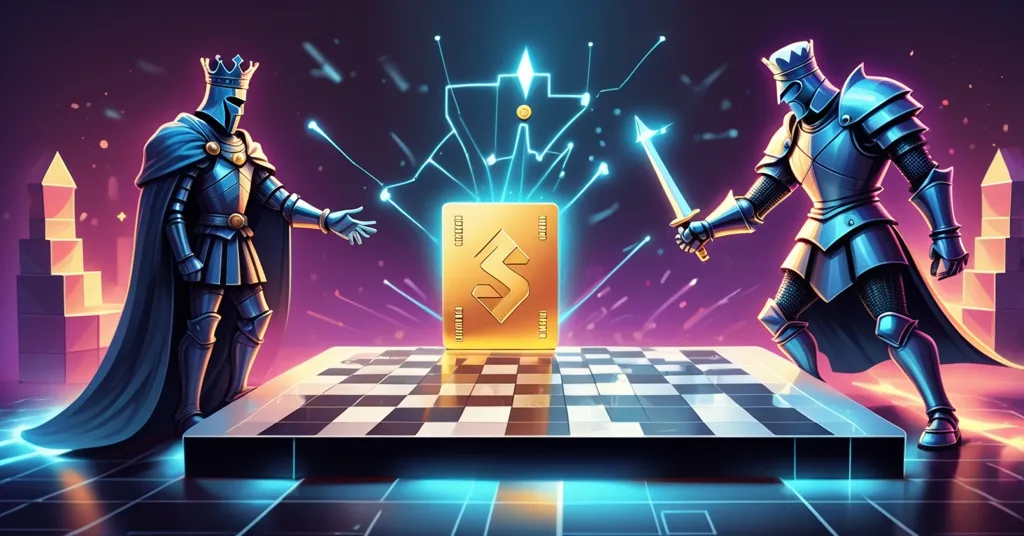Mastercard’s $2B Zerohash Acquisition: Crypto Domination or Dangerous Gamble?

Mastercard’s $2B Zerohash Bid: A Crypto Power Grab with Hidden Risks
Mastercard is reportedly on the verge of a blockbuster deal, engaging in advanced talks to acquire Zerohash, a top-tier cryptocurrency and stablecoin infrastructure provider, for a staggering $1.5 to $2 billion. This aggressive move signals the payment giant’s intent to dominate the blockchain and digital currency arena, but it’s a high-stakes gamble that could either redefine global finance or blow up in their face.
- Deal Scope: Mastercard targeting Zerohash acquisition, valued at $1.5-2 billion.
- Competitive Aim: Positioning to outmaneuver Visa and PayPal in blockchain payments.
- Global Potential: Could overhaul cross-border transactions, especially in regions like Africa.
- Underlying Threat: Stablecoins risk eroding Mastercard’s traditional revenue model.
Why Zerohash? Unpacking the Tech That Caught Mastercard’s Eye
Zerohash, established in 2017, isn’t a consumer-facing crypto app but the backbone that powers digital currency operations for banks and fintechs. Their platform provides the nuts and bolts for stablecoin payments, crypto trading, and tokenization, ensuring seamless integration with regulatory compliance and settlement processes. For those just dipping their toes into crypto, stablecoins are digital currencies tied to stable assets like the US dollar—imagine a digital version of cash that doesn’t swing wildly like Bitcoin, making them ideal for everyday use. Tokenization, meanwhile, is the process of turning real-world assets, like real estate or stocks, into digital tokens on a blockchain—a secure, transparent ledger system. Zerohash’s tech makes this possible at scale, which explains why their $104 million funding round in September, backed by giants like Apollo, Point72 Ventures, Interactive Brokers, and Nyca, pushed their valuation to $1 billion. Mastercard sees this as a golden ticket to embed cutting-edge crypto tools into their vast global network. For more on this potential deal, check out the detailed report on Mastercard’s ambitious crypto expansion.
Battling Visa and PayPal: A Cutthroat Race for Blockchain Supremacy
Mastercard isn’t just keeping pace—they’re swinging for the fences. Rivals like Visa have long forged ties with crypto firms, rolling out blockchain-friendly cards and settlement systems, while PayPal has gone full throttle, letting users buy, sell, and spend cryptocurrencies directly. Mastercard’s strategy with Zerohash is to leap ahead by integrating stablecoin and tokenization capabilities, potentially redefining how payments flow worldwide. But this isn’t their first rodeo; they previously chased BVNK, another stablecoin player, only to get outbid by Coinbase in a last-minute exclusive partnership deal valued around $2 billion. The crypto payment space is a brutal arena, with traditional giants and crypto-native firms like Coinbase duking it out. Add in other players like American Express and fintech disruptors such as Revolut, who are also sniffing around blockchain, and you’ve got a battlefield where hesitation means extinction. Will Zerohash be Mastercard’s winning move, or another missed shot?
Emerging Markets: A Financial Revolution or Empty Hype?
If this acquisition pans out, regions like Africa could witness a dramatic shift in financial access. Cross-border payments in these markets are often a nightmare—remittances, the money sent home by workers abroad, get gouged by fees averaging 6-7% per transaction through systems like SWIFT, according to World Bank figures. Stablecoin transactions on blockchain networks, by contrast, can drop those costs to under 1%. Think of a worker in Nigeria sending funds to family in Kenya instantly via a Mastercard-powered stablecoin app, sidestepping the greedy middlemen of traditional banking. With Zerohash’s infrastructure meshed into Mastercard’s global reach, this could bring digital payment solutions to the unbanked and underbanked, addressing gaps that legacy systems have ignored for decades. Take Kenya’s M-Pesa, a mobile money giant—while revolutionary locally, it still struggles with pricey cross-border fees. A stablecoin alternative could be a game-changer. Yet, challenges like spotty internet access, local regulatory pushback, and consumer trust in digital currencies remain massive hurdles. Is this a genuine lifeline for emerging markets, or just a shiny corporate talking point?
Stablecoins: Mastercard’s Brilliant Yet Dangerous Bet
Here’s the rub: stablecoins could be both a savior and a saboteur for Mastercard. Their traditional business thrives on transaction fees—every swipe or tap through their network earns them a cut. But when a stablecoin payment zips directly from one wallet to another on a blockchain, Mastercard gets nothing. No middleman, no fee. Analysts are sounding alarms that widespread stablecoin adoption could bleed billions from their revenue over time. It’s a savage irony—by embracing crypto to stay relevant, they’re crafting their own potential downfall. Sitting on the sidelines isn’t an option, though, not when Stripe just dropped $1.1 billion on stablecoin startup Bridge for global payroll solutions, and Coinbase locked in BVNK. Mastercard is caught in a disrupt-or-die dilemma, and Zerohash might be their Trojan horse—brilliant until it turns on them.
Bitcoin Maximalists Weigh In: Validation or Violation?
For those of us who see Bitcoin as the pinnacle of decentralized money, this news stirs a conflicted brew of emotions. On one hand, a heavyweight like Mastercard diving into blockchain validates the tech’s power to upend the status quo, aligning with our push for financial freedom and privacy. It’s a nod to effective accelerationism—the idea that speeding up tech adoption, even imperfectly, gets us closer to systemic change. But let’s not drink the corporate Kool-Aid. Stablecoins, often pegged to fiat currencies and controlled by centralized entities (yes, USDC, I’m glaring at your reserve audits), are a far cry from Bitcoin’s censorship-resistant, trustless ethos. Mastercard gobbling up Zerohash risks turning blockchain into another walled garden of Big Finance control, repackaging rebellion as just another profit stream. We champion disruption, but not when it’s a wolf in sheep’s clothing. Is this a step toward mass adoption of decentralized ideals, or a betrayal of what Satoshi envisioned?
Regulatory Shadows: The Wild Card in Mastercard’s Crypto Push
Let’s not ignore the 800-pound gorilla: regulation. Stablecoins are under a global microscope, with the US SEC cracking whips on compliance, the EU rolling out its MiCA framework to govern crypto assets, and other jurisdictions tightening the noose. A Mastercard-Zerohash deal could attract intense scrutiny, especially if it scales stablecoin use in mainstream payments. Will regulators view this as a threat to financial stability, slapping down restrictions or hefty compliance costs? Or will Mastercard’s deep lobbying pockets smooth the path? This isn’t just a business hurdle—it’s a potential dealbreaker. The crypto space is already a regulatory minefield, and a corporate giant stepping in might either legitimize blockchain or paint a bigger target on its back. Either way, the outcome will shape how far this partnership can stretch.
Industry Ripple Effects: Blockchain Goes Mainstream, for Better or Worse
Zooming out, Mastercard’s pursuit of Zerohash slots into a tidal wave of traditional finance embracing blockchain. The crypto market’s rebound over the past year has fueled sky-high valuations and investor confidence, with stablecoin startups becoming the darlings of the payment world. Stripe’s $1.1 billion acquisition of Bridge, focused on crypto for treasury and payroll, and Coinbase’s strategic grab of BVNK are proof that blockchain is no longer a fringe experiment—it’s the future spine of money movement. For emerging markets, this could mean unprecedented access; for the industry, it signals that the old guard is no longer just watching from the sidelines. But here’s the devil’s advocate view: as corporations swarm in, are we trading one centralized system for another? Blockchain’s promise was to dismantle power structures, not hand them new toys. This tension—between acceleration and autonomy—will define the next decade of digital finance.
Key Takeaways and Burning Questions
- What’s pushing Mastercard toward Zerohash?
They’re dead-set on outpacing Visa and PayPal in blockchain payments, banking on Zerohash’s stablecoin and tokenization tech as their secret weapon. - Could this transform regions like Africa?
Absolutely—stablecoin-powered cross-border payments could slash remittance fees and speed up transactions, offering real relief to the unbanked. - Do stablecoins threaten Mastercard’s core business?
Damn right they do. Direct blockchain transactions bypass traditional rails, potentially gutting the fees that keep Mastercard’s engine running. - Is blockchain going mainstream in finance?
No question—with heavyweights like Stripe and Coinbase making similar plays, blockchain is cementing itself as the backbone of modern payments. - Should Bitcoin purists support or slam this move?
It’s a toss-up. While it highlights blockchain’s disruptive force, corporate control over crypto tech risks straying from Bitcoin’s decentralized heart. - How might regulators impact this deal?
Stablecoins are a regulatory hot potato; Mastercard could face strict rules or roadblocks that complicate or even derail their crypto ambitions.
What’s Next in This Financial Showdown?
As we await the final word on whether this deal seals or implodes, one truth stands out: the clash between traditional finance and cryptocurrency is hitting a fever pitch. Mastercard’s bet on Zerohash could rewrite the rules of payments, especially for millions in underserved regions desperate for cheaper, faster options. But at what cost to the soul of decentralization? With regulatory storm clouds gathering and the ever-present risk of self-sabotage via stablecoins, the road ahead looks as volatile as a Bitcoin price chart. One thing’s for sure—this is just the opening act in a financial revolution that’s equal parts thrilling and treacherous. Stay tuned; the stakes couldn’t be higher.



